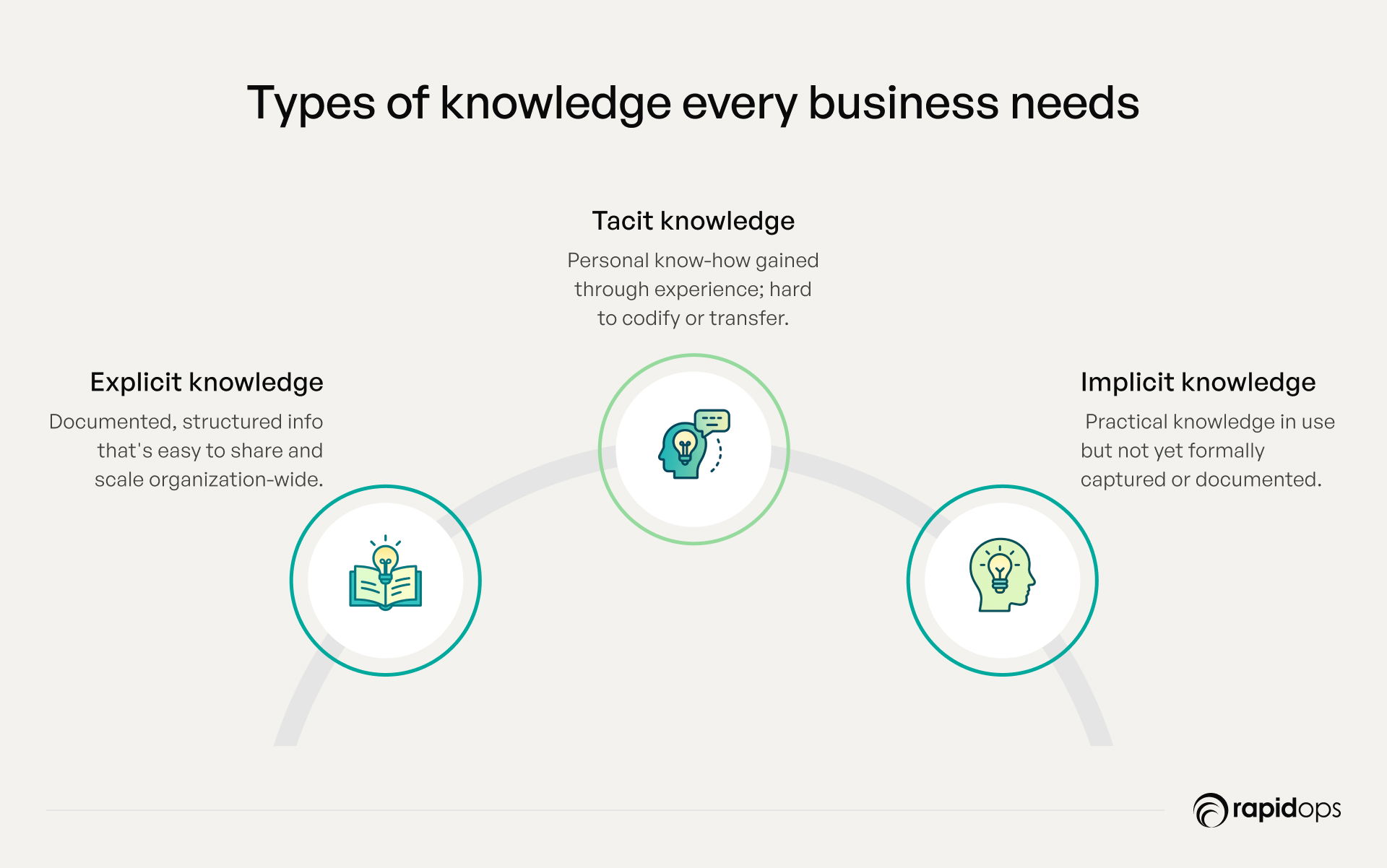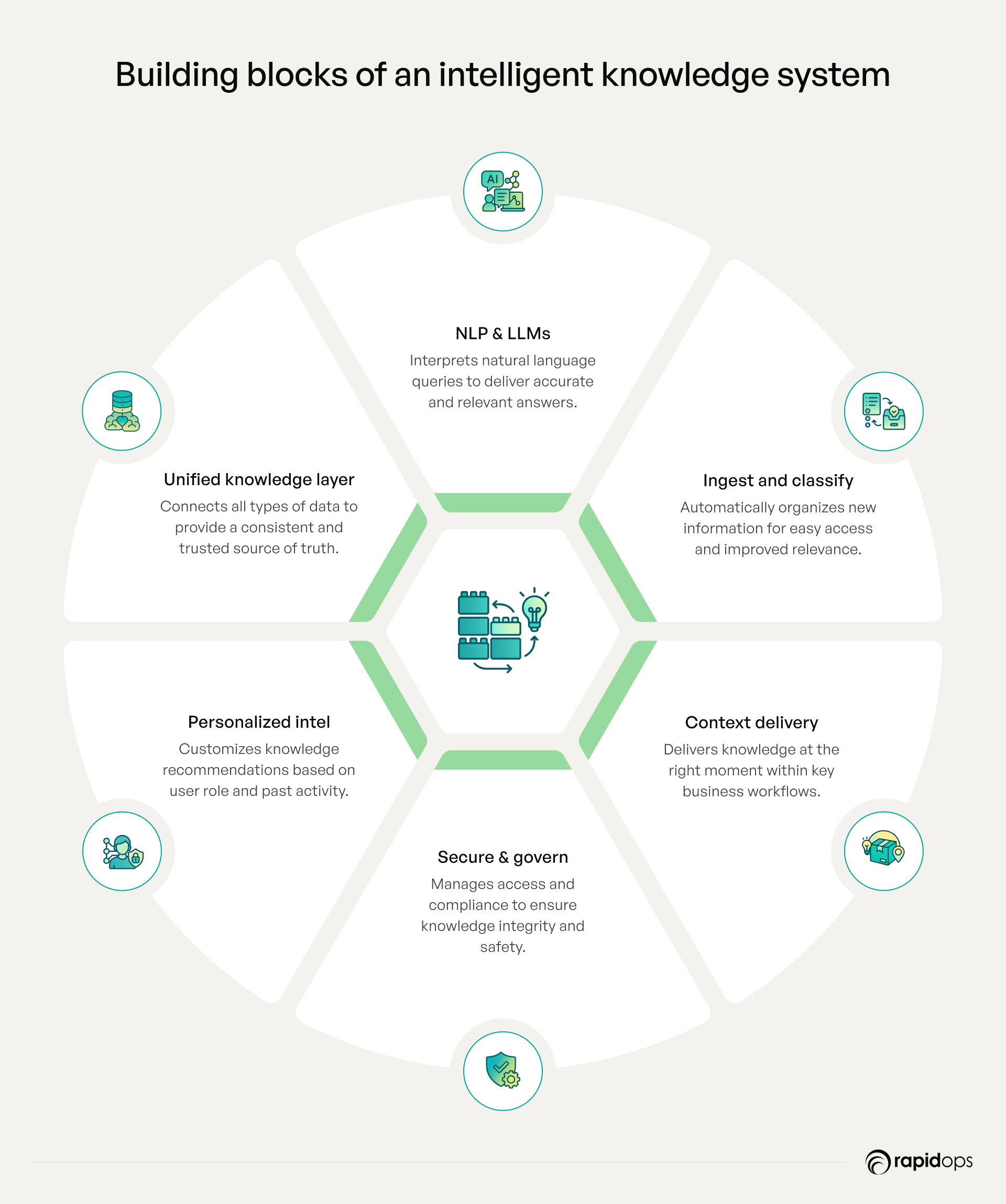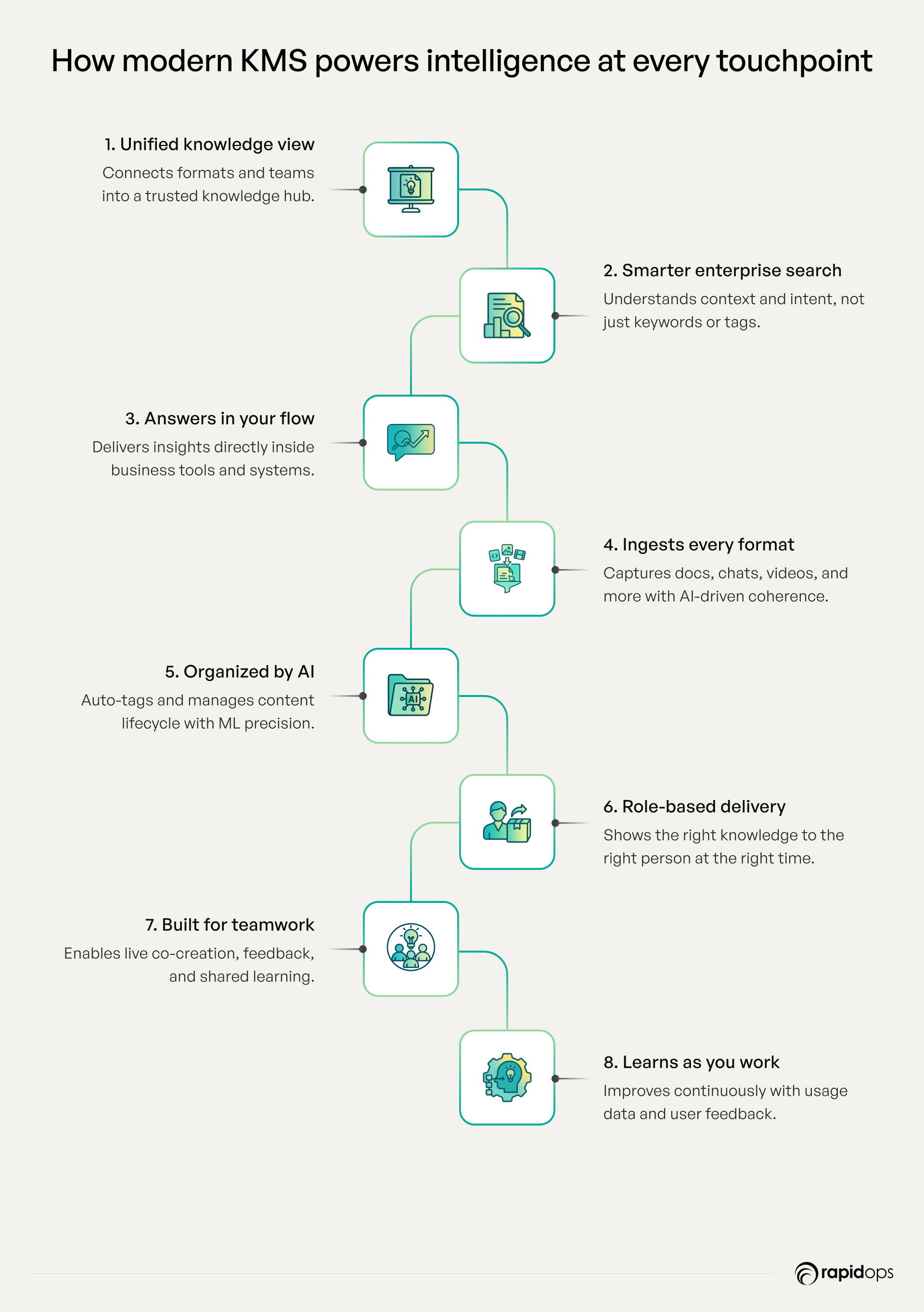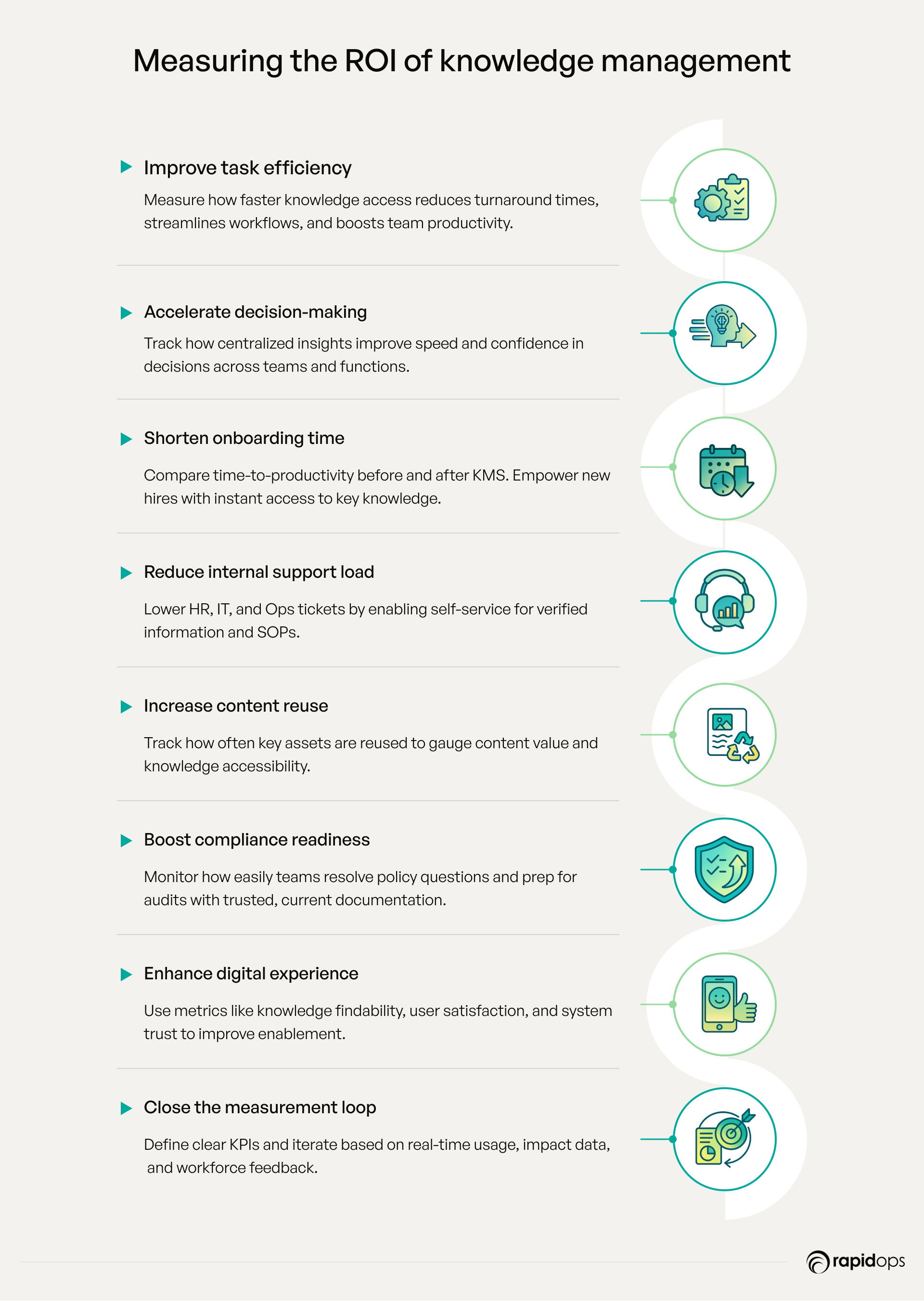In the business landscape, efficiency has always been more than a metric; it’s a defining trait of competitiveness.
For decades, the ability to streamline operations, reduce friction, and make faster decisions has determined whether an organization leads the market or lags behind. And while the pursuit of efficiency isn’t new, the conditions around it have fundamentally changed.
Today, businesses operate in a world flooded with data. Every process, interaction, and system generates vast volumes of information. But instead of accelerating performance, this abundance often slows it down. Teams are forced to dig through disconnected systems, toggle between tools, and re-create knowledge that already exists just to complete routine tasks or make informed decisions.
The pressure to move fast is greater than ever, but ironically, so is the struggle to access what we already know.
And that’s not a technology problem; it’s a knowledge problem.
This is precisely where modern knowledge management systems (KMS) become essential, not as back-office repositories, but as enterprise-wide intelligence layers that turn fragmented data and tribal knowledge into accessible, actionable insight. A well-implemented knowledge management system enables faster decisions, seamless collaboration, and scalable innovation by ensuring that the collective knowledge of the enterprise is always within reach, in the right context, at the right moment.
In today’s fast-moving, information-heavy environment, a knowledge management system isn’t just important. It’s indispensable to sustain operational agility, driving employee productivity, and protecting the institutional memory that fuels long-term growth.
What is a knowledge management system?
A knowledge management system (KMS) is an intelligent, enterprise-wide platform that systematically captures, organizes, contextualizes, and delivers institutional knowledge across the organization. At its core, it connects people, processes, and information by creating a unified knowledge layer that integrates structured data, unstructured content, tribal know-how, and evolving insights into a single, dynamic environment.
But a modern knowledge management system is far more than a static repository. It acts as an intelligent delivery system embedded directly into business workflows and applications. By integrating with tools like ERP, CRM, HRM, and collaboration platforms, a knowledge management system ensures that the right knowledge surfaces at the right moment, whether during decision-making, onboarding, customer service, or compliance.
Under the hood, large language models (LLMs) and natural language processing (NLP) play a foundational role. NLP enables the system to understand user queries in plain language, extract meaning from documents, and organize information contextually. LLMs enhance this by reasoning over vast data sets, generating human-like responses, summarizing complex content, and adapting outputs based on role, intent, and task. This fusion allows users to ask open-ended questions and receive clear, actionable insights without navigating folders or searching through static documents.
The result is a system that reduces friction, accelerates decisions, and minimizes operational inefficiencies. As enterprises scale and evolve, a well-architected knowledge management system becomes a force multiplier, preserving institutional memory, breaking down silos, and turning organizational knowledge into a strategic, AI-powered asset.
How knowledge management system differs from DMS and Wikis
Enterprises often confuse content tools with knowledge systems, but their roles and impact differ significantly.

- Document management systems (DMS)
A DMS is built to store and manage documents, contracts, policies, and reports with strict version control and access rules. It ensures compliance and document traceability but doesn't contextualize or connect knowledge for decision-making.
- Wikis and content libraries
These platforms allow teams to co-create and share content in a more flexible, informal way. They're helpful for quick tips, how-to guides, and tribal knowledge, but lack structure, governance, and integration with business systems.
- Knowledge management systems (KMS)
A KMS goes beyond storing content. It captures critical insights, connects the dots across departments, and delivers relevant knowledge into the flow of work. Unlike DMS or wikis, a KMS is designed to scale expertise, accelerate execution, and turn knowledge into a strategic asset for enterprise agility and growth.
The types of knowledge that shape business performance
Modern enterprises manage three core types of knowledge: explicit, tacit, and implicit, each requiring distinct strategies for capture, transfer, and application.

1. Explicit knowledge: Easily codified and shared
This is structured, well-documented information that can be stored and transmitted with ease. It includes manuals, standard operating procedures, policy documents, and databases. Because it's already written down and formalized, explicit knowledge is the most accessible form, ideal for training, compliance, and enterprise-wide knowledge transfer.
2. Tacit knowledge: Deep expertise embedded in experience
Tacit knowledge lives in people's heads. It's intuitive, context-rich, and shaped by years of practice. Think of a veteran technician who "just knows" when a machine is about to fail, or a leader navigating complex negotiations. It's difficult to articulate, which makes it harder to transfer without immersive methods like mentorship, shadowing, or storytelling.
3. Implicit knowledge: Undocumented but transferable
Implicit knowledge exists in practice but hasn't yet been documented, such as shortcuts in workflows, undocumented know-how, or informal best practices. Unlike tacit knowledge, it can be captured but often gets overlooked. Turning implicit knowledge into explicit knowledge is key to scaling operational efficiency and reducing key-person dependency.
Key components of an intelligent knowledge management system
An intelligent knowledge management system isn’t just defined by where knowledge is stored, it’s defined by how intelligently it is captured, processed, delivered, and evolved across the enterprise. Below are the foundational components that make a modern KMS truly intelligent and enterprise-ready.

1. Unified knowledge layer
This is the core foundation that connects structured data (like databases and ERP entries), unstructured content (like PDFs, emails, and videos), and tribal know-how (like insights from Slack or team notes). It creates a single source of truth across the organization, enabling consistent, contextual access to knowledge regardless of source or format.
2. Natural language processing (NLP) and large language models (LLMs)
NLP engines interpret user queries in natural language, understanding intent, context, and semantics. LLMs then reason over vast knowledge sets to generate accurate, contextual responses. This allows employees to ask questions conversationally and get actionable answers without navigating folders or interfaces.
3. Knowledge ingestion and classification pipeline
An intelligent knowledge management system must continuously ingest new knowledge from documents, tickets, conversations, or external sources. AI-powered classification and enrichment automatically tag, contextualize, and route content into the right categories, ensuring discoverability and relevance at scale.
4. Context-aware delivery engine
Information is only valuable if it appears at the right time, in the right place, for the right person. This component integrates the KMS into business workflows, such as CRM, ERP, HRM, or service platforms, so that knowledge surfaces contextually, whether an agent is resolving a customer issue or a manager is making a critical decision.
5. Security, governance, and access controls
Knowledge systems must enforce robust access management, defining who can view, edit, or share what based on roles, regions, or compliance mandates. This ensures knowledge integrity, minimizes risks, and aligns with enterprise governance policies without creating bottlenecks.
6. Personalization and role-based intelligence
Every user has different needs, from frontline employees to senior executives. Intelligent KMSs personalize knowledge recommendations based on user roles, past behavior, and task context, reducing noise and driving precision. This ensures relevance while enhancing productivity across teams.
These components turn static repositories into adaptive, intelligent systems that scale expertise, speed up execution, and future-proof enterprise knowledge, making them a strategic imperative.
Why knowledge management has become a business imperative
What sets agile enterprises apart isn't just data; it's how institutional knowledge is captured, connected, and turned into action. When expertise is scattered or forgotten, momentum stalls. In a world of constant change, knowledge management has become the engine of resilience, alignment, and innovation, not a support system.
Still, a strategic force shaping how businesses adapt, grow, and lead. That transformation begins with a core shift: empowering teams with fast, contextual access to the knowledge they need, exactly when and where they need it.

1. Prioritizing fast, contextual access to knowledge
Amid the speed and complexity of modern operations, the ability to surface relevant knowledge now of need has become non-negotiable. Whether it's resolving a customer issue, onboarding a new employee, or making a time-sensitive decision, employees can't afford to waste time searching across scattered systems.
A modern knowledge management (KM) system embeds role-specific insights directly into workflows, eliminating friction, reducing cognitive load, and enabling faster, more confident action. This shift from passive repositories to intelligent, real-time knowledge delivery ensures that expertise flows exactly where it's needed instantly, intuitively, and at scale.
2. Meeting rising customer expectations
Customers today expect fast, personalized, and accurate service across every channel. When frontline teams lack access to contextual knowledge, those expectations go unmet. A well-integrated knowledge management system equips service agents and sales teams with real-time insights, improving resolution speed, message consistency, and overall customer satisfaction. By turning knowledge into a real-time asset, enterprises can meet rising expectations without increasing operational burden.
3. Managing exponential information growth
Every interaction, process, and platform generates new information, resulting in fragmented, siloed knowledge that's hard to retrieve. Without a structured knowledge management system framework, critical insights remain buried or duplicated. An effective knowledge management system curates, contextualizes, and connects information across systems, turning information overload into a strategic asset, the result: less time spent searching, and more time spent solving.
4. Mitigating knowledge loss amid workforce transitions
Employee turnover, retirements, and internal moves can cause valuable institutional knowledge to disappear. A modern knowledge management system strategy captures critical know-how before it's lost, making it accessible, updatable, and transferable across teams. This not only preserves organizational memory but also strengthens business continuity and resilience in times of change.
5. Enabling faster onboarding and continuous learning
Reducing time-to-productivity is essential in fast-paced environments. With a strong knowledge management system in place, new hires gain instant access to proven practices, curated learning paths, and role-specific knowledge, accelerating onboarding and reducing ramp-up time. As teams evolve, the same knowledge management foundation supports continuous learning and alignment with shifting business priorities.
6. Driving alignment across distributed teams
As hybrid and global work models expand, keeping teams aligned has become increasingly difficult. Disconnected knowledge leads to inconsistent decisions, duplicated work, and lost opportunities. A centralized knowledge management system acts as a shared source of truth connecting teams across locations, functions, and tools. It promotes clarity, consistency, and collaborative execution at scale.
7. Eliminating redundancies and operational inefficiencies
When teams can't find what already exists, they reinvent solutions, repeat mistakes, and waste valuable time. Knowledge management systems make reusable assets, expert inputs, and validated knowledge easily discoverable, reducing inefficiencies, streamlining workflows, and driving enterprise-wide productivity. Knowledge reuse becomes a competitive advantage, not just an operational fix.
8. Fueling enterprise AI and automation initiatives
AI and automation depend on structured, high-quality knowledge inputs. Whether powering semantic search, automated decision-making, or virtual agents, a well-structured knowledge management foundation ensures data is complete, contextual, and explainable. By organizing and governing enterprise knowledge, knowledge management becomes a key enabler of intelligent automation, accelerating outcomes while maintaining trust and transparency.
9. Accelerating innovation and time-to-value
Innovation flourishes when teams can build on existing knowledge. A robust knowledge management system connects people to past experiments, domain expertise, and validated insights, enabling faster iteration and collective problem-solving. This compresses the cycle from idea to execution, allowing organizations to respond faster to opportunities and bring new offerings to market with confidence. With the right knowledge management foundation, innovation becomes repeatable, scalable, and a true engine of growth.
What a modern knowledge management system looks like today
A modern knowledge management system in 2025 is no longer just a repository; it’s a real-time, intelligent ecosystem that connects people, processes, and insights across the enterprise. Designed for agility, it harnesses AI, semantic understanding, and contextual delivery to turn fragmented information into actionable knowledge. What defines it now is not just how much it stores, but how well it understands, adapts, and empowers decision-making at every level.

1. Enterprise-wide knowledge fabric
Modern knowledge management begins with a unified knowledge architecture where structured, unstructured, and tribal knowledge converge into a centralized yet federated graph. This single source of truth ensures continuity across business units, systems, and formats, eliminating silos and making learning accessible, interpretable, and trusted.
2. Semantic and intent-aware search
Today’s systems understand meaning, not just keywords. Leveraging LLMs and vector-based models, semantic search interprets context, user intent, and domain nuance, delivering the most relevant insights across vast content repositories in milliseconds.
3. Embedded, contextual delivery
Knowledge meets the user where work happens in CRM dashboards, ERP systems, collaboration tools, or service platforms. This in-context integration drives real-time application, reducing friction and elevating decision quality across functions.
4. Multiformat and multimodal knowledge ingestion
Modern knowledge management captures everything from documents and diagrams to audio, video, and chat threads. Using multimodal AI, it transforms disparate formats into coherent, searchable, and analyzable assets preserving intent, nuance, and meaning.
5. AI-powered classification and lifecycle automation
Advanced ML models automatically tag, classify, and organize content using consistent taxonomies. They also manage the knowledge lifecycle from publishing to archiving based on usage patterns, regulatory needs, and business relevance.
6. Personalization and policy-aware access
KMS systems dynamically tailor knowledge based on user roles, tasks, and policy constraints. Whether it’s frontline staff or compliance teams, access is governed, relevant, and timely, ensuring security without compromising usability.
7. Real-time collaboration and co-creation
Modern knowledge management enables teams to co-author, annotate, and evolve knowledge in live environments. These collaborative spaces turn shared problem-solving into living knowledge captured, discoverable, and reusable across the enterprise.
8. Feedback-driven continuous optimization
With every interaction, the system learns. Usage analytics, content feedback, and performance signals feed back into the system, guiding updates, identifying gaps, and fine-tuning delivery for higher relevance and precision.
9. LLM-native assistance and reasoning
Large Language Models are now integral, not optional. They support natural language querying, summarization, content generation, and intelligent recommendations. This conversational layer makes enterprise knowledge more accessible, proactive, and capable of driving informed action.
10. API-first, scalable, future-ready
Built for extensibility, modern KM platforms operate on an API-first foundation, seamlessly integrating with internal systems, cloud services, and external data. This ensures the KMS can scale with business transformation and remain resilient in a fast-evolving digital ecosystem.
Use cases of knowledge management systems across industries
Across industries, modern knowledge management systems are transforming how work gets done enabling frontline agility, accelerating decision-making, and preserving expertise where it’s needed most. Their impact is now operational, not optional.
1. Empowering every employee with real-time knowledge access
Modern knowledge management systems enable frontline workers, such as store associates, field service engineers, and machine operators, to access critical information when needed. Whether it's troubleshooting a malfunctioning device, referencing safety procedures, or assisting a customer with product specifications, real-time access reduces reliance on supervisors and improves first-time resolution.
Mobile-optimized interfaces, role-based search, and AI-recommended content ensure relevance and speed. This minimizes downtime, enhances compliance, and strengthens frontline agility. In high-turnover environments, it ensures continuity by embedding expertise directly into the tools workers already use, supporting consistent performance even as teams scale or shift.
2. Standardizing operational processes across locations
Enterprises with distributed operations often face inconsistencies in workflows, quality checks, or safety protocols. A centralized knowledge management system acts as a single source of truth, ensuring that every location, from regional warehouses to global manufacturing plants, follows standardized SOPs, regulatory compliance, and quality benchmarks.
Content versioning, multilingual access, and permission-based controls help tailor information without fragmenting the core standards. By embedding process documentation, audit trails, and real-time updates, organizations maintain operational harmony across sites. The result is reduced variation, fewer compliance risks, and improved performance benchmarking across the enterprise.
3. Accelerating onboarding and upskilling across roles
Modern knowledge management systems transform onboarding by delivering role-specific learning paths integrated with contextual knowledge. New hires in production, logistics, or retail can access structured tutorials, visual guides, and real-time SOPs tailored to their functions, reducing dependence on live trainers and shortening ramp-up times.
Smart tagging and AI-driven content recommendations help learners discover relevant materials while doing their jobs. Upskilling becomes continuous as knowledge evolves with business needs, empowering employees to adapt to new systems or workflows quickly. This not only improves training ROI but also builds a resilient, cross-trained workforce ready for dynamic operational demands.
4. Enabling smarter supply chain decisions through shared knowledge
Supply chain operations demand speed, transparency, and collaboration across functions. A modern knowledge management system unifies vendor contracts, shipment policies, customs regulations, incident response playbooks, and historical performance data, making them instantly accessible to supply chain managers, logistics teams, and procurement officers.
AI categorization and federated search allow users to connect dots across siloed functions and regions. This shared visibility empowers teams to anticipate disruptions, respond to exceptions with agility, and negotiate more effectively with partners. By breaking down informational silos, enterprises turn data into actionable knowledge, improving service levels, fulfillment rates, and cost efficiency across the supply chain.
5. Preserving institutional knowledge amid workforce transitions
As experienced professionals retire or rotate, their domain expertise often leaves with them. A modern knowledge management system helps capture this institutional knowledge by enabling experts to document workflows, heuristics, and decision logic through guided templates, video explainers, and process maps.
AI assists in indexing and contextualizing these inputs, ensuring future teams can easily retrieve and apply them. Unlike traditional manuals, this dynamic repository evolves with time and becomes embedded into daily workflows. It preserves not just what people know, but how they think, creating a sustainable knowledge loop that futureproofs the organization against workforce churn and skill gaps.
6. Enhancing customer experience with unified product and service information
Customer-facing teams need immediate access to accurate, consistent, and comprehensive information to deliver seamless experiences. A centralized knowledge system integrates product specifications, warranty details, inventory levels, pricing rules, and service policies across all channels: retail, digital, and support.
Sales reps, contact centers, and chatbots alike draw from the same source, ensuring every interaction reflects real-time updates and consistent messaging. AI enhances relevance by surfacing context-aware answers during conversations or transactions. This improves first-contact resolution, reduces misinformation, and builds trust. More importantly, it turns knowledge into a strategic asset for differentiating customer experience at scale.
How to measure the ROI of a knowledge management system
Measuring the ROI of a modern knowledge management system (KMS) isn’t just about cost-cutting; it’s about quantifying how better knowledge access drives business performance, agility, and workforce enablement. Here’s a structured, outcome-focused framework to assess value across the enterprise.

1. Improve task efficiency and reduce turnaround time
Track how quickly employees complete tasks before and after KMS deployment. A well-designed system embeds contextual knowledge within day-to-day workflows, eliminating the need to search across documents, tools, or teams. This reduces delays, cuts wait time between handoffs, and boosts productivity across functions from service to operations to decision support.
2. Accelerate decision-making across the enterprise
Evaluate how the KMS impacts the speed and quality of business decisions. By centralizing historical insights, best practices, and institutional memory, the system shortens the time to insight, enabling teams to launch products faster, respond quicker to market shifts, and reduce time lost to second-guessing or duplication.
3. Reduce onboarding ramp-up time
Compare pre- and post-knowledge management system onboarding timelines. A centralized knowledge hub gives new hires fast access to role-relevant documentation, SOPs, and FAQs, reducing dependence on peers and accelerating time-to-productivity. This results in lower onboarding costs and quicker integration of talent into high-impact roles.
4. Decrease internal support tickets and operational rework
Measure reductions in support requests to HR, IT, and Ops teams, as well as the frequency of recurring errors. When employees can self-serve verified knowledge, it lowers ticket volumes, reduces rework cycles, and frees up teams to focus on high-value, strategic work.
5. Track knowledge reuse to quantify content value
Monitor how often knowledge assets such as playbooks, documents, or resolutions are reused across teams. High reuse signals that knowledge is not only well-captured but also discoverable and applicable. Analyzing these trends helps prioritize the creation and enhancement of high-impact assets.
6. Strengthen compliance and audit readiness
Measure time-to-resolution for policy-related queries and audit preparation cycles. With up-to-date procedures and regulations stored in one place, teams reduce compliance risk, improve governance, and spend less time chasing documentation during audits or assessments.
7. Enhance employee enablement and digital experience
Capture metrics on employee satisfaction, digital friction, and knowledge findability. A seamless KMS experience builds trust in systems, fosters autonomy, and supports learning, leading to better engagement, cross-functional collaboration, and lower attrition.
8. Apply a closed-loop measurement framework
Begin with clearly defined KPIs such as task completion time, onboarding speed, reuse rate, support ticket volume, etc. Leverage analytics to monitor outcomes continuously, identify bottlenecks, and iterate knowledge flows to match evolving business and workforce needs.
Common pitfalls when implementing a knowledge management system
Organizations often initiate knowledge management system (KMS) programs with the goal of capturing institutional knowledge, improving decision-making, and enabling collaboration. However, the execution frequently reveals structural, cultural, and operational challenges that undermine these objectives.
Below are the most common pitfalls that compromise the effectiveness of knowledge management system initiatives.

1. Treating KM as a content repository, not a strategic platform
When KM is reduced to a digital filing cabinet, it becomes disconnected from enterprise priorities. This limited perspective leads to stagnant, outdated information pools that serve as reference archives rather than active enablers of insight. The system becomes passive, used only for retrieval, not for contextual learning or application across the business.
2. Low user adoption due to poor design or usability
Many knowledge management system implementations overlook user behavior and expectations, resulting in complex interfaces, rigid structures, and slow response times. When employees find the system frustrating or unintuitive, they revert to informal methods of knowledge sharing or avoid engaging altogether, creating gaps in collective understanding.
3. No motivation or incentives for knowledge contribution
When knowledge-sharing activities are seen as nonessential or unrecognized, participation remains low. Employees may deprioritize contributing insights, viewing it as time-consuming or outside their responsibilities. This leads to an imbalanced system where a small set of contributors carry the burden while most users remain passive consumers.
4. Siloed tools and disconnected business units
In many organizations, knowledge exists in tool-specific repositories aligned to particular functions or teams. These fragmented systems prevent cross-functional visibility and create duplication, misalignment, and barriers to collaboration. Disconnected knowledge management environments reinforce organizational silos rather than breaking them down.
5. Failure to embed knowledge management into daily workflows and systems
When knowledge management operates in parallel to the actual work environment, it is often perceived as an extra step rather than a value-adding resource. Employees may neglect updating or consulting the system, leading to underutilization and stale content. This misalignment with operational context results in reduced relevance and poor adoption.
6. No alignment between KM outcomes and business KPIs
Knowledge management system initiatives often lack clearly defined success criteria tied to business performance. When the system’s impact on metrics like efficiency, customer satisfaction, or time-to-resolution is unclear, executive support diminishes. This disconnect reduces strategic visibility and weakens organizational commitment to knowledge management over time.
When is the right time to adopt a knowledge management system
Most enterprises don’t realize they need a modern knowledge management system (KMS) until business performance is directly impacted. It’s not about documentation, it’s about decisions, agility, and scalability. Below are strategic signals that it's time to invest in a purpose-built KMS:
1. Day-to-day decisions are delayed due to fragmented information
If employees spend more time locating critical information than acting on it, decision velocity suffers. Slow responses to market shifts, customer needs, or operational issues directly impact growth and agility. A KMS centralizes knowledge, eliminates silos, and accelerates decision-making across functions.
2. Scaling operations without scaling knowledge is creating bottlenecks
As enterprises expand, workflows multiply, but institutional knowledge often doesn’t. When teams duplicate efforts or recreate past learnings, efficiency drops. A KMS scales knowledge distribution alongside growth, enabling faster onboarding, process continuity, and operational resilience.
3. AI and analytics are underdelivering due to unstructured knowledge
AI initiatives stall when foundational knowledge is scattered across emails, documents, and tribal silos. A KMS provides structured, contextual, and machine-readable knowledge that enables intelligent automation, improves model accuracy, and accelerates time to value.
4. Compliance and audit processes are manual and high-risk
If regulatory audits involve chasing down policies, SOPs, or outdated files, you’re exposed to avoidable risk. A KMS ensures every document is versioned, accessible, and traceable, strengthening governance and reducing compliance-related penalties.
5. Institutional expertise is leaving faster than it’s being captured
When experienced employees retire, churn, or shift roles, undocumented insights vanish. This weakens decision quality and business continuity. A modern knowledge management system preserves critical know-how and ensures it’s accessible long after employees move on.
6. Cross-functional collaboration and innovation are stalling
Disconnected knowledge creates friction between departments. If innovation cycles are slow and collaboration is reactive, your teams may be wasting effort on redundant work. A knowledge management system fosters reuse of insights, enables faster experimentation, and aligns decision-making across functions.
7. Support teams are repeating known answers and wasting time
High support volumes for issues that have been solved before indicate poor knowledge reuse. A knowledge management system powers self-service portals, improves resolution quality, and reduces ticket volumes, freeing up teams to focus on high-impact work.
8. Onboarding and training lack consistency across teams
While not the primary driver, inconsistent onboarding leads to productivity gaps and errors. A knowledge management system streamlines role-specific learning, speeds up ramp-up time, and ensures every new hire starts with the same baseline of knowledge regardless of geography or function.
If your teams are working harder to find what they already know, it’s a signal that your business is paying a hidden tax. A modern KMS turns scattered information into enterprise intelligence driving faster decisions, scalable growth, and AI-readiness.
When knowledge flows, your business grows
Knowledge is the engine behind every successful enterprise, the experience, context, and insight that fuels faster innovation, smarter decisions, and sustainable growth. But its true value is unlocked only when it flows freely, accessible, actionable, and embedded across every function.
If your teams are held back by fragmented tools, siloed expertise, or slow decision-making, the impact goes beyond operations; it hinders agility, alignment, and long-term competitiveness. These challenges are a signal to rethink how your organization captures, connects, and activates knowledge at a scale.
With 16+ years of experience in enterprise transformation, Rapidops builds intelligent, human-centered knowledge management systems tailored to how your business works. Our platforms surface the right insights at the right time, so your teams act with speed, clarity, and confidence. Whether it’s reducing onboarding time, accelerating collaboration, or enabling real-time decisions, we help you turn knowledge into a strategic advantage.
Ready to reimagine how knowledge flows across your enterprise?
Talk to our experts to explore how Rapidops can help you transform disconnected information into business intelligence that drives measurable outcomes. Schedule a free consultation with one of our knowledge management experts today.
Frequently Asked Questions
How does a KMS improve organizational efficiency?
A knowledge management system (KMS) eliminates information silos by centralizing institutional knowledge and making it accessible across departments. This streamlines workflows, reduces duplication of effort, accelerates decision-making, and ensures teams operate with the most accurate, up-to-date insights, ultimately improving enterprise-wide productivity and alignment.
What problems does a knowledge management system solve?
A knowledge management system addresses fragmented knowledge, inconsistent processes, and lost expertise. It helps enterprises retain critical institutional knowledge, reduce onboarding time, minimize rework, and eliminate the delays caused by searching for scattered information. It also supports compliance, innovation, and real-time collaboration.
Why do growing enterprises need a KMS?
As enterprises scale, so does complexity. A knowledge management system ensures that knowledge grows with the organization, not against it, by capturing expertise, standardizing best practices, and enabling seamless collaboration across geographies and teams. It creates the foundation for scalable decision-making, innovation, and continuous improvement.
Is knowledge management relevant for small and mid-sized businesses?
Absolutely. Smaller businesses often rely heavily on individual expertise. A knowledge management system protects that knowledge from being lost due to turnover, supports faster onboarding, and helps teams scale operations without reinventing processes. It builds a strong knowledge foundation early, giving SMBs an edge as they grow.
In what ways can a KMS enhance customer service?
A knowledge management system gives customer-facing teams real-time access to the most relevant product knowledge, troubleshooting steps, and policy updates, enabling faster, more consistent, and personalized service. It reduces resolution time, enhances customer satisfaction, and empowers support teams to operate with confidence and accuracy.
Why do companies invest in knowledge management systems?
Enterprises invest in knowledge management system to improve agility, reduce operational friction, and retain institutional knowledge. It’s a strategic enabler for digital transformation, helping companies move faster, respond to change, and make informed decisions at scale. The ROI shows up in productivity, customer experience, and innovation velocity.
What happens if a business doesn’t have a proper KMS in place?
Without a knowledge management system, knowledge remains fragmented or lost entirely, especially during turnover or restructuring. Teams rely on outdated information, decisions take longer, and innovation stalls. Over time, the organization becomes less agile, less aligned, and more vulnerable to inefficiencies and competitive pressures.
Does a knowledge management system save time and money?
Yes. A well-implemented knowledge management system significantly reduces time spent searching for information, redoing work, or training new employees. It lowers support costs, improves operational efficiency, and drives faster time-to-value across business processes, making it a high-ROI investment for long-term growth.

Rahul Chaudhary
Content Writer
With 5 years of experience in AI, software, and digital transformation, I’m passionate about making complex concepts easy to understand and apply. I create content that speaks to business leaders, offering practical, data-driven solutions that help you tackle real challenges and make informed decisions that drive growth.
What’s Inside
- What is a knowledge management system?
- How knowledge management system differs from DMS and Wikis
- The types of knowledge that shape business performance
- Key components of an intelligent knowledge management system
- Why knowledge management has become a business imperative
- What a modern knowledge management system looks like today
- Use cases of knowledge management systems across industries
- How to measure the ROI of a knowledge management system
- Common pitfalls when implementing a knowledge management system
- When is the right time to adopt a knowledge management system
- When knowledge flows, your business grows

Let’s build the next big thing!
Share your ideas and vision with us to explore your digital opportunities
Similar Stories
- Transformation
- undefined Mins
- March 2022

- Transformation
- undefined Mins
- March 2020


Receive articles like this in your mailbox
Sign up to get weekly insights & inspiration in your inbox.

